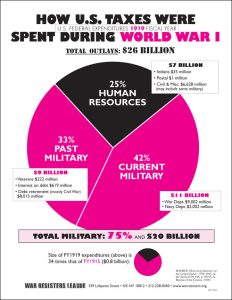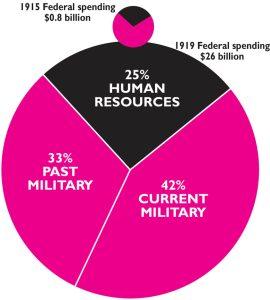[Editor’s Note: Ed Hedemann created this post for a portion of NWTRCC’s website in 2015 that no longer exists. With it being the 100th anniversary of War Resisters League this year, it seemed appropriate to re-post it.]
Had the War Resisters League been founded a few years earlier than 1923 and was producing its annual pie charts, what would they look like? The image below gives one idea. (Click here to download a PDF)
 A striking difference between this fictional WW I era pie chart and today’s version is how much simpler the federal budget was back then. Not only was it a lot smaller – vastly smaller – there were many fewer categories. A hundred years ago, the budget was mostly military (75% of the budget) – even before entry into WW I – a large part of which was to pay off expenses incurred during the Civil War from 50 years earlier and the recently-ended Spanish-American War. The nonmilitary portions were labeled “Indians,” “Postal Deficiencies,” and “Civil and Miscellaneous”.1
A striking difference between this fictional WW I era pie chart and today’s version is how much simpler the federal budget was back then. Not only was it a lot smaller – vastly smaller – there were many fewer categories. A hundred years ago, the budget was mostly military (75% of the budget) – even before entry into WW I – a large part of which was to pay off expenses incurred during the Civil War from 50 years earlier and the recently-ended Spanish-American War. The nonmilitary portions were labeled “Indians,” “Postal Deficiencies,” and “Civil and Miscellaneous”.1
With the onset of WW I, the growth (from 1915 to 1919) in spending exploded to 35 times the pre-war level, that’s not 35% but 3500%. Federal spending went from $750 million to $26,000 million.
Fundraising for War
 Consequently, a hundred years ago the government had to raise a lot of money in a hurry. In 1915 before U.S. entry into the war, the main sources of revenue were excise taxes ($330 million), customs duties ($210 million), internal revenue ($80 million), among other sources ($75 million) totaling almost $700 million.
Consequently, a hundred years ago the government had to raise a lot of money in a hurry. In 1915 before U.S. entry into the war, the main sources of revenue were excise taxes ($330 million), customs duties ($210 million), internal revenue ($80 million), among other sources ($75 million) totaling almost $700 million.
But at the height of the war (1919) government receipts mushroomed to $5,200 million, which was made up of excise taxes ($870 million), customs ($180 million), corporate and individual income taxes ($3,400 million), other IR taxes ($1,300 million), miscellaneous ($560 million) … and, most importantly, a lot of borrowing. Total public debt before the war was a bit over $1,200 million, but by the end of World War I it had grown to $24,000 million, composed primarily of War Bonds, Liberty Loans, and Treasury Bills.
Perhaps not too surprisingly, politicians were as sneaky then as they are now. Today we have “black budgets,” deceptive and vaguely-worded programs, and outright buried expenses. Back then, a telling footnote on the military spending relates, “Excludes civil expenditures under War and Navy Departments … Additional expenditures for ‘War activities’ are reflected in the total for ‘Other expenditures’.”1
Following the war — as had been the case with all previous U.S. wars — the military budget dropped precipitously such that by 1923 it was only 5% of what it was at its peak WW I levels. However, interest on the national debt (largely a result of the war) blew up to 45 times the pre-war level.
War Tax Resistance During World War I
Tax resistance during World War I was a lot more difficult to do then than it is today. A hundred years ago most people weren’t subject to the recently passed (never passed, as some claim) individual income tax and the zombie-like telephone tax — just revived from the Spanish-American War — which affected the very few who actually had telephones. However, the supposedly voluntary War Bonds and Liberty Loans were often enforced by vigilante mobs who attacked as traitors those who didn’t buy enough or purchase them at all, including pacifists, conscientious objectors, socialists, anarchists, and pro-German sympathizers. (For some graphic examples, see Refusal to Buy World War I Bonds, The Picket Line)
Interestingly, for more than 20 years following the end of WW I, the United States was not involved in any wars. Until 1941. Ever since there has been only one year that the United States was not entangled in at least one war.
A hundred years ago as now, whatever the United States has spent on its wars, past wars, and preparation for future wars, it’s been way too much. The budget of the United States has always been a war budget, a budget that protects the powerful and the wealthy, no matter how much they try to dress it up with pleasing social programs to coax the populous to swallow the bitter pill of war spending.2
~Post by Ed Hedemann
1. All figures are from the Statistical Abstract: Historical Statistics of the United States 1789-1945, Bureau of the Census, 1949; or Historical Statistics of the United States, Colonial Times to 1970, Bureau of the Census, 1975.
2. Naturally, there are those on the right who would prefer to gut the entire budget except for whatever the Pentagon wants.
